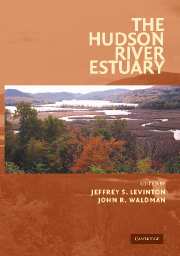Book contents
- Frontmatter
- Contents
- Preface
- List of Contributors
- The Hudson River Estuary
- 1 The Hudson River Estuary: Executive Summary
- GEOLOGICAL, PHYSICAL, AND CHEMICAL SETTING OF THE HUDSON
- PRIMARY PRODUCTION, MICROBIAL DYNAMICS, AND NUTRIENT DYNAMICS OF THE HUDSON
- 8 Bacterial Abundance, Growth, and Metabolism in the Tidal Freshwater Hudson River
- 9 Primary Production and Its Regulation in the Tidal-Freshwater Hudson River
- 10 Wastewater and Watershed Influences on Primary Productivity and Oxygen Dynamics in the Lower Hudson River Estuary
- 11 Modeling Primary Production in the Lower Hudson River Estuary
- HUDSON RIVER COMMUNITIES, FOOD WEBS, AND FISHERIES
- CONTAMINANTS AND MANAGEMENT ISSUES OF THE HUDSON RIVER ESTUARY
- Index
- Plate section
- References
9 - Primary Production and Its Regulation in the Tidal-Freshwater Hudson River
Published online by Cambridge University Press: 06 January 2010
- Frontmatter
- Contents
- Preface
- List of Contributors
- The Hudson River Estuary
- 1 The Hudson River Estuary: Executive Summary
- GEOLOGICAL, PHYSICAL, AND CHEMICAL SETTING OF THE HUDSON
- PRIMARY PRODUCTION, MICROBIAL DYNAMICS, AND NUTRIENT DYNAMICS OF THE HUDSON
- 8 Bacterial Abundance, Growth, and Metabolism in the Tidal Freshwater Hudson River
- 9 Primary Production and Its Regulation in the Tidal-Freshwater Hudson River
- 10 Wastewater and Watershed Influences on Primary Productivity and Oxygen Dynamics in the Lower Hudson River Estuary
- 11 Modeling Primary Production in the Lower Hudson River Estuary
- HUDSON RIVER COMMUNITIES, FOOD WEBS, AND FISHERIES
- CONTAMINANTS AND MANAGEMENT ISSUES OF THE HUDSON RIVER ESTUARY
- Index
- Plate section
- References
Summary
abstract Photosynthesis is the main process by which new organic matter is synthesized. In many aquatic ecosystems, phytoplankton are the major photosynthetic organisms and are responsible for most of the organic C input. In the tidal-freshwater Hudson, primary production by phytoplankton is maintained at relatively low values by a combination of high turbidity and deep mixing (which lowers light availability), advective losses downstream and consumption by grazers. Limitation by nitrogen or phosphorus, the most common plant limiting nutrients, is not an important regulatory factor in the tidal-freshwater Hudson. Respiration by the phytoplankton themselves is the major fate of phytoplankton-derived organic matter (gross primary production), leaving relatively small amounts available to higher trophic levels. Thus, small increases in grazing pressure could have large impacts on phytoplankton. Phytoplankton biomass and gross primary production were dramatically reduced by the 1992 invasion of the zebra mussel, and phytoplankton have not yet recovered to pre-invasion levels. We estimate that phytoplankton gross primary production was 331 g C m−2 y−1 in the years prior to the zebra mussel invasion and 82 g C m−2 y−1 in the years following. This is from about one-half to one-eighth as large as the input of terrestrial organic C from the watershed.
Introduction
Primary production is the formation of organic compounds from inorganic building blocks. The energy required to synthesize these organic products may come from sunlight (photosynthesis); from chemical reactions, (chemosynthesis, e.g. ammonia or sulfide oxidation); or a mixture of the two as in some types of an oxygenic bacterial photosynthesis (Brock, 1979).
- Type
- Chapter
- Information
- The Hudson River Estuary , pp. 107 - 120Publisher: Cambridge University PressPrint publication year: 2006
References
- 12
- Cited by



